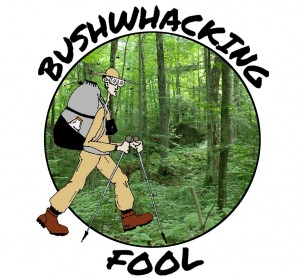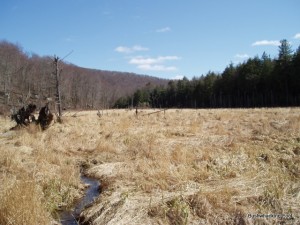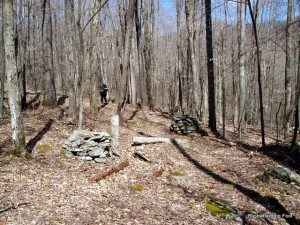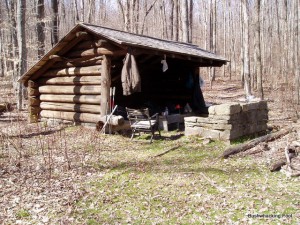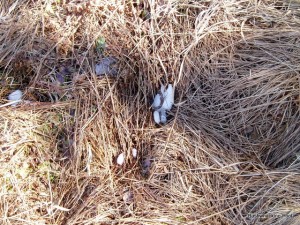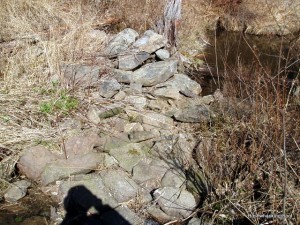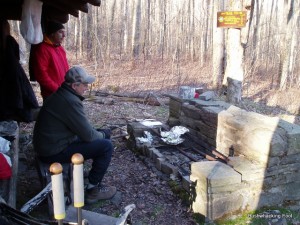As the snow melts and the cold temperatures recede, the early plants begin to emerge from the once frozen ground and the Easter bunny begins collecting his eggs, these signs can mean only one thing, the Frostbite Overnight (FBON) is fast approaching, of course! In 2012, this annual backpacking event is in its 27th year, my 15th straight year of participation.
As is tradition, the trip takes our merry band of intrepid adventurers to the Catskill State Park. This year to Pelnor Hollow, at the recommendation of a co-worker of mine, who is originally from the area. Pelnor Hollow is just a couple ridges east from Trout Pond, where the previous year’s FBON took place. Although there will be no attractive ponds this year, there should be a pretty view from a ridge top, weather conditions allowing.
In addition to my friend Dave and me, Tom is joining us for the first time after several years’ absence. Three people complicate logistics somewhat, but since they are both meeting me at my place, I am free to concentrate on the single task remaining after finishing my usual early morning hectic packing effort. With a scheduled arrival time of ten in the morning of April 5, this gives me plenty of time to run down and fulfill one of the time-honored traditions of obtaining flat bread from the Columbus Bakery on Pearl Street in Syracuse.
Dave arrives first around ten minutes ahead of time, but luckily well after I return from my bakery run. While catching up after not seeing each other for a year, Tom finally arrived and we packed up Dave’s vehicle for the couple hour trip down to Roscoe, NY.
The drive goes by quickly and without much that is noteworthy. Unlike last year, there is no snowfall and the weather remains mostly sunny, but with cool temperatures. The conversation remains light and airy, with both Dave and Tom checking their cellphone insistently. While driving along the Delaware River we make our first bird sighting of note, a beautiful bald eagle.
When we roll into Roscoe, we make a few stops for groceries, as well as somewhere Tom can buy a hat for the trip. We take our time, as there is little reason for making haste; the hike into the lean-to is less than a mile. The short hike in allows for carrying in some extra foodstuffs we might avoid on a longer hike in.
First, we hit a grocery store along one of the main streets in Roscoe. Despite the early afternoon hour on a Thursday, there are plenty of people milling about on the sidewalks. Despite the activity on the streets, the small grocery store is nearly empty. While I buy nothing, both Dave and Tom pick up several items. At my urging, Tom buys a package of three strip steaks to share the first night, my mouth salivating at the thought of them cooking over an open fire.
A small sporting goods store yields a great choice of hats for Tom. I select an attractive fedora for him, which he quickly rejects, picking a rather unremarkable baseball hat with a fish embroidered on it. Judging by how many times he repeated it, he liked the idea of appearing as a local. Yeah, right! More like a fishing tourist up from the city.
Numerous cutouts were scattered around Roscoe, like those at carnivals of old, where one stands behind and places their head through the hole, cutout for that very purpose. There are different painted images on each, typically fishing-themed, although one shows a striking appearance to Woody Woodpecker. Although we pass many as we walked around the village, none of us shows the courage to step behind one and have our photograph taken. Fear at showing up on Facebook or some other place on the Internet being the primary cause, no doubt.
Finally, we head north toward our final destination for the day at the end of Pelnor Hollow Road. Momentary confusion ensues, as road names fail to any of the many maps we continually consult. Upon finally finding Pelnor Hollow Road, we continue north despite Dave’s TomTom GPS continuously warning us to “Please turn around as soon as possible,” as it indicates we are driving where no road exists.
Briefly, construction equipment blocking the narrow road forces us to wait, while it excavates the adjacent hillside. After a moments delay we continue up an increasingly rough and narrowing road. At two points, we pass over very narrow bridges, before the road finally ends at a camp. Although the road continues as a dirt jeep trail at this point, is remains questionable whether the vehicle can continue further.
A sign at the end the road indicates a parking area ahead a short ways along the jeep trail. Since there is no place to park in front of the camp, we decide to scout out the jeep trail and make sure Dave’s vehicle can make it up without too much trouble.
The road is rough with some ruts, exposed rocks and wet areas, but it appears sound enough to drive a vehicle up, especially one equipped with 4-wheel drive. As Dave takes a break, Tom and I continue walking up the jeep trail. At one significant muddy rut, Tom decides to do some road construction when I step on a large rock at the edge of the road and it slides down into the rut. Rather than get mud-covered, I continue on for a little ways farther up the road.
Since the road has enough muddy ruts in it, Tom and I regroup and decide that it probably is not a wise idea to drive Dave’s vehicle up any farther. Just as we turn around and proceed back, we notice a vehicle coming up the road right towards us. Thinking it a pick-up truck, we make way for it on the road, only to discover Dave already took some initiative and made an executive decision to drive up without our advice. Smart thinking.
I continued to walk in front of Dave’s vehicle, making sure the remainder of the road is firm enough, and to clear it of small downed limbs that might get caught up underneath. Fortunately, Dave never floored the accelerator and we all make it to the small, grassy parking lot at the end of the road. The parking lot is probably a slight misnomer as it is more like an intersection with the way straight ahead blocked with a barrier. The intersecting road, more of a grassy lane, disappears downhill to the right but some muddy tracks indicates it still get some use.
Off the far end of the parking lot is the trail to the Pelnor Hollow lean-to. It immediately climbs uphill and disappears into the maturing hardwood forest following blue disks on the occasional tree. After some changing, and a little repacking, we start down the trail for the short walk to the lean-to. It is two-thirty in the afternoon when we leave behind the parking lot, right on schedule.
The trail quickly levels off, and remains so except for an infrequent short up and down along the way. We frequently pass rock cairns along the trail, the large flat rocks carefully piled on top of each other, perhaps the remains of rock walls all but long gone. The forest remains largely mature maple throughout, the lack of leaves allowing for viewing the surrounding topography for far distances. A black-capped chickadee occasionally and emphatically announces its presence, repeating its familiar call repeatedly.
In less than a mile, we arrive at the Pelnor Hollow lean-to. The shelter is within a small clearing surrounded by the same maple forest we traveled through from the parking lot. It stands on a level section along the side of a ridge, with the ridge climbing gradually behind it and declining from the entrance down to a large open beaver meadow.
Rubus bushes surround the lean-to. Although leafless, their thorns are as painful as always, which we discover numerous times during our stay there. Unfortunately, they are many months from producing their tasty berries, although in the shade of the forest, most likely the berries would be in short supply anyways.
A large fireplace stands in front of the lean-to, which we plan putting to good use later cooking our steaks. The lean-to is furnished with a folding wooden chair, a bench, two brooms (one covered with gnaw marks) and a short-handled rake. The wooden chair and bench get much use during our stay, the wooden chair by far judged the favorite amenity.
The trail continues through the lean-to site, climbing up the ridge behind the lean-to. A New York State Department of Environmental Conservation (DEC) sign nailed to a tree in front of the lean-to, indicates the many potential destinations for our hike tomorrow, although the Split Rock Lookout appears the general consensus.
We settle into the lean-to for our two-night stay, where I am fortunate enough to secure one of the coveted spots along the outside wall, and therefore avoid being sandwiched between two snoring middle-aged men. We unpack enough of our gear to mark adequately our territory just in the unlikely probability that anyone else arrives later in the day.
Interestingly, the Adirondack Mountain Club’s Guide to Catskill Trails, 2nd edition indicates there is a large pond downslope from the lean-to. My co-worker, who advised this trip, told me that same about this same pond. Obviously, the pond is long gone, especially based on the density and height of the vegetation within the current meadow.
Without anything else planned for the day, we decide the meadow begs for further exploration. After navigating through the Rubus around the lean-to, we head downhill to the edge of the meadow. At the bottom of the slope, located near the meadow’s edge is a bubbling spring, surrounded with flat rocks, unfortunately appearing a little like a primitive toilet. The water flows out continuously, meandering through the meadow away from the lean-to.
Initially, we start our short hike by going out into the meadow, but quickly the wetness forces us off into the surrounding forest. I spot a few small patches of snow in sheltered areas of grass, the first ones encountered thus far on this trip. Softwood forest surrounds the southern side of the meadow, while the opposite side is all hardwood trees, primarily red maple.
The softwood forest is primarily eastern hemlock, with an occasional eastern white pine thrown in for good measure. The interior is dark and foreboding, the dense canopy blocking all but the most stubborn of sunlight. The ground has a hummock and hollow topography under the softwood trees, with a few pools of water within some of the small depressions.
Once we reach the meadow’s far side, we emerge from the forest and approach the narrowing end of the meadow, where a rock wall straddles the stream’s outlet. Could this have once been a dam that created the pond? While Tom and I hung out near the dam, Dave continues down the narrow clearing straddling the stream until disappearing out of sight.
By the time Dave returns, we cross the stream and transition to the hardwood side of the meadow. Instead of being mostly level, the ground climbs from the meadow’s edge up to a ridgeline far beyond. Large slabs of rock form small cliffs here, with much Rubus scattered about under the trees.
As we start to near the lean-to, we encounter a rock wall near the edge of the meadow, revealing a more intensive land use of the area from the distant past. Soon after the rock wall, a strong stench fills the air. Ahead of us, in a slightly wetter area, bright green plants stand amongst the dull brown of last year’s leaf litter. The emerging plant life signal what is to come in the near future as spring begins to give way to summer. The strong onion-like smell permeates the air here, emanating from the newly sprouted vegetation.
After returning to the lean-to, we sit around discussing numerous subjects before starting our dinner. Since cooking the steaks Tom bought in Roscoe, and the hot dogs Dave brought with him, a fire is a necessity. We gather wood, which is in great supply surrounding the lean-to, and soon have a plethora of hot coals to cook over. Dave shares his hot dogs with all, while Tom has a big bowl of Dinty Moore Beef Stew as an appetizer. We share some beer while enjoying steak and cheese sandwiches made from flat bread from Columbus Bakery.
As day gives way to early evening, the temperature drops quickly, so we retreat to our respective sleeping bags. As the fire continues to smolder, the coals remain hot for much of the night, the smoke frequently filling the lean-to, much to our dismay.
During one smoke-out, an eastern phoebe flies into the lean-to while we are still occupying it. The bird flies to the middle crossbeam, alighting there momentarily, then flying away with the realization that the shelter is otherwise occupied. After each attempt, the phoebe flies off to a nearby tree branch, vocalizing its displeasure by calling out its name. Finally, after several attempts, the bird disappears, obviously looking for another place to roost for the night.
As the moon rises above the ridge behind the lean-to, we emerge from our sleeping bags for a short hike down to the edge of the meadow to take in the clear evening sky. Despite some light from the rising moon behind us, the sky is awash with stars, something I fail to notice living in a populated area for the majority of my time.
We retire early, listening to Dave’s radio as we drift off to sleep in preparation of the longer hike tomorrow. And, of course, our Happy Hour tradition afterwards.
Affiliate Disclaimer: Some links within this blog post may send you to a retailer website. If you chose to purchase any product on that site at that time, this author receives a small commission. These commissions provide compensation for the author’s time and effort necessary to provide the content at the Bushwhacking Fool.
